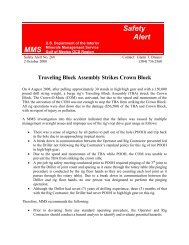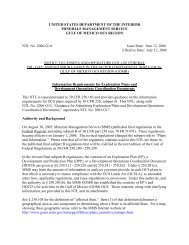Deepwater Gulf of Mexico 2004: America's Expanding ... - OCS BBS
Deepwater Gulf of Mexico 2004: America's Expanding ... - OCS BBS
Deepwater Gulf of Mexico 2004: America's Expanding ... - OCS BBS
- No tags were found...
Create successful ePaper yourself
Turn your PDF publications into a flip-book with our unique Google optimized e-Paper software.
Beneath the 3,000-ft (914-m) water depth, other currents migrate around the deep waters <strong>of</strong> the GOM.<br />
Until recently, these deep currents were thought to be minimal and were not a major consideration in most<br />
structure designs. In 1999, industry reported significant currents on the <strong>OCS</strong> below 3,000 ft (914 m).<br />
This information led to a Safety Alert and subsequent study <strong>of</strong> deep currents by MMS (Hamilton et al.,<br />
2003). This study revealed significant deep currents <strong>of</strong> up to 2 kn at some locations. The effects <strong>of</strong> all<br />
currents must be considered in the design <strong>of</strong> deepwater floating production facilities, drilling rigs, and<br />
their ancillary equipment, such as steel catenary risers and mooring systems.<br />
Recent incidents have revealed the need for more accurate data in hind-casting and forecasting events and<br />
in daily operations. As a result, MMS is proposing to issue an NTL titled “Ocean Current Monitoring on<br />
Floating Facilities.” This NTL could establish and implement a program where operators <strong>of</strong> deepwater<br />
<strong>of</strong>fshore production facilities and mobile <strong>of</strong>fshore drilling units (MODU’s) collect data on ocean currents<br />
and submit them for publication on an industry-sponsored Internet website. Data collected on currents<br />
will improve fatigue forecast models and establish responsible design criteria, resulting in increased<br />
reliability <strong>of</strong> deepwater structures, thereby reducing risk to human lives, <strong>of</strong>fshore facilities, and the ocean<br />
environment.<br />
CHALLENGES AND REWARDS<br />
Significant challenges exist in deepwater in addition to environmental considerations. <strong>Deepwater</strong><br />
operations are very expensive and <strong>of</strong>ten require significant amounts <strong>of</strong> time between the initial<br />
exploration and first production. Despite these challenges, deepwater operators <strong>of</strong>ten reap great rewards.<br />
Figure 16 shows the history <strong>of</strong> discoveries in the deepwater GOM. There was a shift toward deeper water<br />
over time, and the number <strong>of</strong> deepwater discoveries continues at a steady pace. Note that the last frame<br />
<strong>of</strong> this figure only represents a 3-year span and that several recent discoveries are not shown in this frame<br />
because they have not been assigned a discovery date yet. (The Reserves and Production section <strong>of</strong> this<br />
report explains how discovery dates are assigned.)<br />
Figure 17 shows how major and nonmajor oil and gas companies compare in terms <strong>of</strong> deepwater project<br />
discoveries. (Appendix E lists those companies defined as majors.) In the past, major companies were<br />
responsible for the majority <strong>of</strong> discoveries and led the way into the deepest waters. However, the number<br />
<strong>of</strong> discoveries by nonmajor companies has surpassed that by major companies. In addition, nonmajor<br />
companies have made numerous recent discoveries in the deepest waters <strong>of</strong> the frontier.<br />
In addition to the significant number <strong>of</strong> deepwater discoveries, the flow rates <strong>of</strong> deepwater wells and the<br />
field sizes <strong>of</strong> deepwater discoveries are <strong>of</strong>ten quite large. These factors are critical to the economic<br />
success <strong>of</strong> deepwater development. Figure 18 illustrates the estimated sizes and distributions <strong>of</strong><br />
80 proved deepwater fields. In addition to their large sizes, deepwater fields have a wide geographic<br />
distribution and range in geologic age from Pleistocene through Paleocene. Note that only recently have<br />
reservoirs older than Miocene been encountered.<br />
The growing number <strong>of</strong> large deepwater fields on production requires increasing support from onshore<br />
service bases. Most producing deepwater fields have service bases in southeast Louisiana (figure 19).<br />
Pending exploration plans (EP’s) and development operations coordination documents (DOCD’s) filed<br />
with MMS indicate that support from southeastern Louisiana will continue to grow and that additional<br />
support will come from southwest Louisiana, Mississippi, and the Texas coast (figure 20). Although<br />
expanding along the <strong>Gulf</strong> Coast, shore-based support for deepwater operations is likely to remain<br />
concentrated in southeastern Louisiana.<br />
Figure 21 illustrates existing and potential hubs for deepwater production. For purposes <strong>of</strong> this report,<br />
deepwater hubs are defined as surface structures that host production from one or more subsea projects.<br />
These hubs represent the first location where subsea production surfaces and the connection point to the<br />
existing pipeline infrastructure. Note that potential hubs are moving into deeper waters, expanding the<br />
infrastructure, and facilitating additional development in the ultra-deepwater frontier.<br />
26







